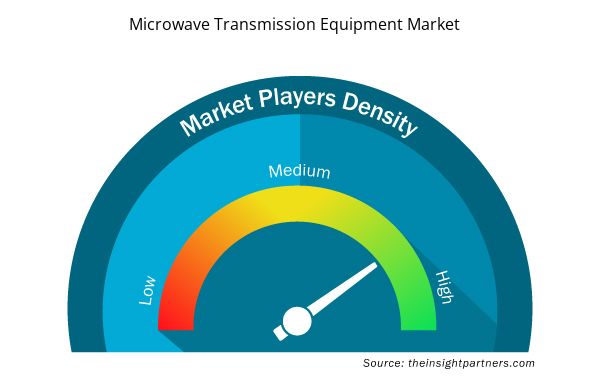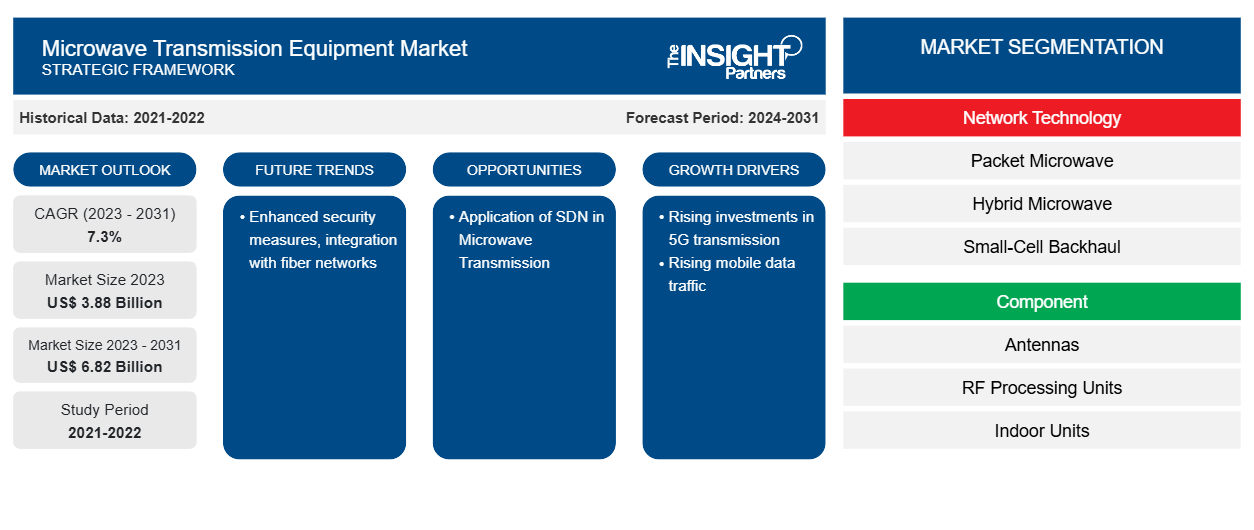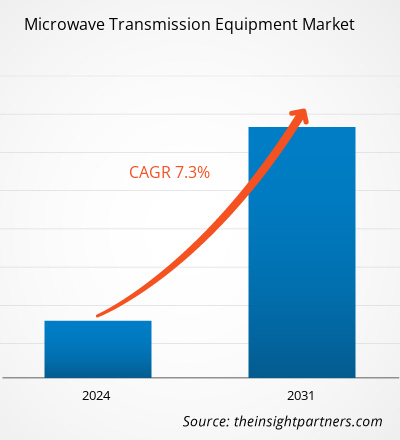Der Markt für Mikrowellenübertragungsgeräte soll von 3,88 Milliarden US-Dollar im Jahr 2023 auf 6,82 Milliarden US-Dollar im Jahr 2031 anwachsen. Der Markt wird zwischen 2023 und 2031 voraussichtlich eine durchschnittliche jährliche Wachstumsrate von 7,3 % verzeichnen. Verbesserte Sicherheitsmaßnahmen und die Integration in Glasfasernetze dürften weiterhin ein wichtiger Trend auf dem Markt bleiben.
Marktanalyse für Mikrowellenübertragungsgeräte
Mikrowellen sind eine drahtlose Sichtverbindungstechnik, die Hochgeschwindigkeitsverbindungen ermöglicht und das Senden und Empfangen von Daten, Videos und Telefonanrufen mithilfe hochfrequenter Radiowellen ermöglicht. Die Funkkommunikation im Weltraum, die Satellitenkommunikation und Punkt-zu-Punkt-Kommunikationssysteme auf der Erde nutzen häufig Mikrowellenfunkübertragung. Radare, Funknavigationssysteme, Sensorsysteme und die Radioastronomie nutzen andere Teile des Mikrowellenfunkbereichs.
Marktübersicht für Mikrowellenübertragungsgeräte
Aufgrund des explosionsartigen Wachstums des mobilen Datenverkehrs, das durch 4G und 5G vorangetrieben wird, sind Dienstanbieter gezwungen, ihre mobile Backhaul-Kapazität mithilfe von Glasfaser-/Kupfer- und drahtlosen Technologien zu erhöhen. Investitionen in die 5G-Infrastruktur gewinnen weltweit an Dynamik. Darüber hinaus nimmt der Datenverkehr zu; dies macht die Entwicklung von Backhaul-Lösungen mit Mikrowellenübertragungsgeräten erforderlich. Dies treibt das Marktwachstum voran.
Passen Sie diesen Bericht Ihren Anforderungen an
Sie erhalten kostenlose Anpassungen an jedem Bericht, einschließlich Teilen dieses Berichts oder einer Analyse auf Länderebene, eines Excel-Datenpakets sowie tolle Angebote und Rabatte für Start-ups und Universitäten.
- Holen Sie sich die wichtigsten Markttrends aus diesem Bericht.Dieses KOSTENLOSE Beispiel umfasst eine Datenanalyse von Markttrends bis hin zu Schätzungen und Prognosen.
Treiber und Chancen auf dem Markt für Mikrowellenübertragungsgeräte
Steigende Investitionen in 5G-Übertragung begünstigen den Markt
5G soll Nutzern jederzeit und überall Zugriff auf mehr als 100 Mbit/s ermöglichen. Die durchschnittliche und Spitzenbandbreite einer 5G-Basisstation wird zehnmal höher sein als die von 4G-Netzwerken und über 1 Gbit/s bzw. 10 Gbit/s betragen. Die Weiterentwicklung der Mikrowellentechnologien hat zu einem Anstieg der Mikrowellenbandbreite von Mbit/s auf Gbit/s geführt. Die Mikrowellenbandbreite wird 10 Gbit/s ermöglichen, wenn innovativere Technologien eingeführt werden, darunter Multiple-Input Multiple-Output (MIMO), Carrier Aggregation (CA), E-Band mit großer Kapazität und die Kombination von Common-Band mit E-Band. Dies wird den Bandbreitenbedarf für 5G vollständig decken. Weltweit wurden über zwei Millionen Mikrowellengeräte installiert. Im Zeitalter von 5G müssen Mikrowellen das Beste aus ihrer vorhandenen Ausrüstung herausholen, indem sie Teile (wie Platinen und ODUs) nur minimal ersetzen. Dies schützt nicht nur die Anfangsinvestitionen der Betreiber, sondern beschleunigt auch die Entwicklung von 5G.
Anwendung von SDN in der Mikrowellenübertragung
Im Dezember 2021 wurden von Ericsson und Telefónica Deutschland / O2 bedeutende Fortschritte bei der Bereitstellung und Verwaltung von Software-Defined Networking (SDN) für Mikrowellennetze erzielt. Um dem Kommunikationsdienstleister (CSP) die Bereitstellung einer herstellerunabhängigen SDN-Schnittstelle in seinem bundesweiten O2-Netz zu ermöglichen, hat Ericsson sein MINI-LINK-Mikrowellenproduktportfolio im O2-Netz aktiviert. Somit ergeben sich für die Dienstanbieter auf dem Markt Möglichkeiten, die Netzwerkflexibilität und Skalierbarkeit durch den Einsatz von SDN bei der Mikrowellenübertragung zu verbessern.
Segmentierungsanalyse des Marktberichts für Mikrowellenübertragungsgeräte
Wichtige Segmente, die zur Ableitung der Marktanalyse für Mikrowellenübertragungsgeräte beigetragen haben, sind Netzwerktechnologie, Komponenten, Frequenzband, Montageart und Anwendung.
- Basierend auf der Netzwerktechnologie ist der Markt für Mikrowellenübertragungsgeräte in Paketmikrowellen, Hybridmikrowellen, Small-Cell -Backhaul und Zeitmultiplex unterteilt. Das Paketmikrowellensegment hatte im Jahr 2023 den größten Anteil.
- Basierend auf den Komponenten ist der Markt in Antennen, HF-Verarbeitungseinheiten, Inneneinheiten (IDU), Außeneinheiten (ODU) sowie Kabel und Steckverbinder unterteilt.
- Basierend auf dem Frequenzband ist der Markt in L-Band, S-Band, C-Band, X-Band, Ku-Band, Ka-Band, Q-Band und andere unterteilt.
- Basierend auf der Montageart ist der Markt in Full-Indoor-, Split-Mount- und Full-Outdoor-Montage unterteilt.
- Basierend auf der Anwendung ist der Markt in Navigation, Mobilfunk, Funktelekommunikation, Satellitenkommunikation, Radar und Breitbandkommunikation unterteilt.
Marktanteilsanalyse für Mikrowellenübertragungsgeräte nach Geografie
Der geografische Umfang des Marktberichts für Mikrowellenübertragungsgeräte ist hauptsächlich in fünf Regionen unterteilt: Nordamerika, Asien-Pazifik, Europa, Naher Osten und Afrika sowie Süd- und Mittelamerika.
Nordamerika hält im Jahr 2023 einen bedeutenden Anteil am Markt für Mikrowellenübertragungsgeräte. In der Region gibt es eine große Anzahl von 5G-Rollout-Projekten, die die Nachfrage nach Mikrowellenübertragungsgeräten unterstützen. Staatliche Unterstützung und Initiativen in der Region unterstützen die digitale Transformation der Kommunikationsinfrastruktur stark und treiben so das Wachstum des Marktes in der Region voran.
Regionale Einblicke in den Markt für Mikrowellenübertragungsgeräte
Die regionalen Trends und Faktoren, die den Markt für Mikrowellenübertragungsgeräte während des gesamten Prognosezeitraums beeinflussen, wurden von den Analysten von Insight Partners ausführlich erläutert. In diesem Abschnitt werden auch die Marktsegmente und die Geografie von Mikrowellenübertragungsgeräten in Nordamerika, Europa, im asiatisch-pazifischen Raum, im Nahen Osten und Afrika sowie in Süd- und Mittelamerika erörtert.

- Erhalten Sie regionale Daten zum Markt für Mikrowellenübertragungsgeräte
Umfang des Marktberichts über Mikrowellenübertragungsgeräte
| Berichtsattribut | Details |
|---|---|
| Marktgröße im Jahr 2023 | 3,88 Milliarden US-Dollar |
| Marktgröße bis 2031 | 6,82 Milliarden US-Dollar |
| Globale CAGR (2023 - 2031) | 7,3 % |
| Historische Daten | 2021-2022 |
| Prognosezeitraum | 2024–2031 |
| Abgedeckte Segmente | Von Network Technology
|
| Abgedeckte Regionen und Länder | Nordamerika
|
| Marktführer und wichtige Unternehmensprofile |
|
Marktteilnehmerdichte für Mikrowellenübertragungsgeräte: Auswirkungen auf die Geschäftsdynamik verstehen
Der Markt für Mikrowellenübertragungsgeräte wächst rasant, angetrieben durch die steigende Nachfrage der Endnutzer aufgrund von Faktoren wie sich entwickelnden Verbraucherpräferenzen, technologischen Fortschritten und einem größeren Bewusstsein für die Vorteile des Produkts. Mit steigender Nachfrage erweitern Unternehmen ihr Angebot, entwickeln Innovationen, um die Bedürfnisse der Verbraucher zu erfüllen, und nutzen neue Trends, was das Marktwachstum weiter ankurbelt.
Die Marktteilnehmerdichte bezieht sich auf die Verteilung der Firmen oder Unternehmen, die in einem bestimmten Markt oder einer bestimmten Branche tätig sind. Sie gibt an, wie viele Wettbewerber (Marktteilnehmer) in einem bestimmten Marktraum im Verhältnis zu seiner Größe oder seinem gesamten Marktwert präsent sind.
Die wichtigsten auf dem Markt für Mikrowellenübertragungsgeräte tätigen Unternehmen sind:
- NEC Corporation
- Huawei Technologies Co., Ltd.
- Telefonaktiebolaget LM Ericsson
- SIAE MICROELETTRONICA-Gruppe
- Intracom Telecom
- Nokia Corporation
Haftungsausschluss : Die oben aufgeführten Unternehmen sind nicht in einer bestimmten Reihenfolge aufgeführt.

- Überblick über die wichtigsten Akteure auf dem Markt für Mikrowellenübertragungsgeräte
Neuigkeiten und aktuelle Entwicklungen zum Markt für Mikrowellenübertragungsgeräte
Der Markt für Mikrowellenübertragungsgeräte wird durch die Erfassung qualitativer und quantitativer Daten nach Primär- und Sekundärforschung bewertet, die wichtige Unternehmensveröffentlichungen, Verbandsdaten und Datenbanken umfasst. Nachfolgend sind einige der Entwicklungen auf dem Markt für Mikrowellenübertragungsgeräte aufgeführt:
- NEC Corporation (NEC; TSE: 6701) gab heute bekannt, dass es eine endgültige Vereinbarung mit Aviat Networks, Inc. (Aviat; Nasdaq: AVNW), dem führenden Experten für drahtlose Transport- und Zugangslösungen, getroffen hat, um sein Wireless Transport Business mit dem von Aviat im Rahmen einer Vermögenskauftransaktion im Wert von 70,0 Millionen US-Dollar in bar und Aktien zu integrieren. (Quelle: NEC Corporation, Pressemitteilung, Mai 2023)
- Huawei hat auf dem Mobile World Congress (MWC) 2023 in Barcelona seine Mikrowellen-Technologie der nächsten Generation MAGICSwave vorgestellt. MAGICSwave nutzt generationsübergreifende Innovationen, um Betreibern beim Aufbau vereinfachter Zielnetze zu helfen, die besser auf die langfristige 5G-Entwicklung ausgerichtet sind, da sie die Gesamtbetriebskosten (TCO) optimieren und die Entwicklung des Transportnetzes reibungslos gestalten. (Quelle: Huawei Technologies Co., Ltd., Pressemitteilung, März 2023)
Marktbericht zu Mikrowellen-Übertragungsgeräten – Umfang und Ergebnisse
Der Bericht „Marktgröße und Prognose für Mikrowellenübertragungsgeräte (2021–2031)“ bietet eine detaillierte Analyse des Marktes, die die folgenden Bereiche abdeckt:
- Marktgröße und Prognose für Mikrowellenübertragungsgeräte auf globaler, regionaler und Länderebene für alle wichtigen Marktsegmente, die im Rahmen des Berichts abgedeckt sind
- Markttrends für Mikrowellenübertragungsgeräte sowie Marktdynamik wie Treiber, Einschränkungen und wichtige Chancen
- Detaillierte PEST/Porters Five Forces- und SWOT-Analyse
- Marktanalyse für Mikrowellenübertragungsgeräte, die wichtige Markttrends, globale und regionale Rahmenbedingungen, wichtige Akteure, Vorschriften und aktuelle Marktentwicklungen umfasst
- Branchenlandschaft und Wettbewerbsanalyse, die die Marktkonzentration, Heatmap-Analyse, prominente Akteure und aktuelle Entwicklungen auf dem Markt für Mikrowellenübertragungsgeräte umfasst
- Detaillierte Firmenprofile
- Historische Analyse (2 Jahre), Basisjahr, Prognose (7 Jahre) mit CAGR
- PEST- und SWOT-Analyse
- Marktgröße Wert/Volumen – Global, Regional, Land
- Branche und Wettbewerbsumfeld
- Excel-Datensatz



Report Coverage
Revenue forecast, Company Analysis, Industry landscape, Growth factors, and Trends

Segment Covered
This text is related
to segments covered.

Regional Scope
North America, Europe, Asia Pacific, Middle East & Africa, South & Central America

Country Scope
This text is related
to country scope.
Häufig gestellte Fragen
The Microwave transmission equipment market is expected to register a CAGR of 7.3% during 2023–2031
The Microwave transmission equipment market size is projected to reach US$ 6.82 billion by 2031
Enhanced security measures and integration with fiber networks are likely to remain key trends in the market.
NEC Corporation, Huawei Technologies Co., Ltd., Telefonaktiebolaget LM Ericsson, SIAE MICROELETTRONICA Group, Intracom Telecom, Nokia Corporation, Anritsu, Aviat Networks, Inc., and Ceragon Networks Ltd. are among the leading payers operating in the Microwave transmission equipment market.
Rising investments in 5G transmission and rising mobile data traffic are expected to drive the Microwave transmission equipment market.
North America dominated the Microwave transmission equipment market in 2023.
Trends and growth analysis reports related to Electronics and Semiconductor : READ MORE..
The Insight Partners performs research in 4 major stages: Data Collection & Secondary Research, Primary Research, Data Analysis and Data Triangulation & Final Review.
- Data Collection and Secondary Research:
As a market research and consulting firm operating from a decade, we have published and advised several client across the globe. First step for any study will start with an assessment of currently available data and insights from existing reports. Further, historical and current market information is collected from Investor Presentations, Annual Reports, SEC Filings, etc., and other information related to company’s performance and market positioning are gathered from Paid Databases (Factiva, Hoovers, and Reuters) and various other publications available in public domain.
Several associations trade associates, technical forums, institutes, societies and organization are accessed to gain technical as well as market related insights through their publications such as research papers, blogs and press releases related to the studies are referred to get cues about the market. Further, white papers, journals, magazines, and other news articles published in last 3 years are scrutinized and analyzed to understand the current market trends.
- Primary Research:
The primarily interview analysis comprise of data obtained from industry participants interview and answers to survey questions gathered by in-house primary team.
For primary research, interviews are conducted with industry experts/CEOs/Marketing Managers/VPs/Subject Matter Experts from both demand and supply side to get a 360-degree view of the market. The primary team conducts several interviews based on the complexity of the markets to understand the various market trends and dynamics which makes research more credible and precise.
A typical research interview fulfils the following functions:
- Provides first-hand information on the market size, market trends, growth trends, competitive landscape, and outlook
- Validates and strengthens in-house secondary research findings
- Develops the analysis team’s expertise and market understanding
Primary research involves email interactions and telephone interviews for each market, category, segment, and sub-segment across geographies. The participants who typically take part in such a process include, but are not limited to:
- Industry participants: VPs, business development managers, market intelligence managers and national sales managers
- Outside experts: Valuation experts, research analysts and key opinion leaders specializing in the electronics and semiconductor industry.
Below is the breakup of our primary respondents by company, designation, and region:

Once we receive the confirmation from primary research sources or primary respondents, we finalize the base year market estimation and forecast the data as per the macroeconomic and microeconomic factors assessed during data collection.
- Data Analysis:
Once data is validated through both secondary as well as primary respondents, we finalize the market estimations by hypothesis formulation and factor analysis at regional and country level.
- Macro-Economic Factor Analysis:
We analyse macroeconomic indicators such the gross domestic product (GDP), increase in the demand for goods and services across industries, technological advancement, regional economic growth, governmental policies, the influence of COVID-19, PEST analysis, and other aspects. This analysis aids in setting benchmarks for various nations/regions and approximating market splits. Additionally, the general trend of the aforementioned components aid in determining the market's development possibilities.
- Country Level Data:
Various factors that are especially aligned to the country are taken into account to determine the market size for a certain area and country, including the presence of vendors, such as headquarters and offices, the country's GDP, demand patterns, and industry growth. To comprehend the market dynamics for the nation, a number of growth variables, inhibitors, application areas, and current market trends are researched. The aforementioned elements aid in determining the country's overall market's growth potential.
- Company Profile:
The “Table of Contents” is formulated by listing and analyzing more than 25 - 30 companies operating in the market ecosystem across geographies. However, we profile only 10 companies as a standard practice in our syndicate reports. These 10 companies comprise leading, emerging, and regional players. Nonetheless, our analysis is not restricted to the 10 listed companies, we also analyze other companies present in the market to develop a holistic view and understand the prevailing trends. The “Company Profiles” section in the report covers key facts, business description, products & services, financial information, SWOT analysis, and key developments. The financial information presented is extracted from the annual reports and official documents of the publicly listed companies. Upon collecting the information for the sections of respective companies, we verify them via various primary sources and then compile the data in respective company profiles. The company level information helps us in deriving the base number as well as in forecasting the market size.
- Developing Base Number:
Aggregation of sales statistics (2020-2022) and macro-economic factor, and other secondary and primary research insights are utilized to arrive at base number and related market shares for 2022. The data gaps are identified in this step and relevant market data is analyzed, collected from paid primary interviews or databases. On finalizing the base year market size, forecasts are developed on the basis of macro-economic, industry and market growth factors and company level analysis.
- Data Triangulation and Final Review:
The market findings and base year market size calculations are validated from supply as well as demand side. Demand side validations are based on macro-economic factor analysis and benchmarks for respective regions and countries. In case of supply side validations, revenues of major companies are estimated (in case not available) based on industry benchmark, approximate number of employees, product portfolio, and primary interviews revenues are gathered. Further revenue from target product/service segment is assessed to avoid overshooting of market statistics. In case of heavy deviations between supply and demand side values, all thes steps are repeated to achieve synchronization.
We follow an iterative model, wherein we share our research findings with Subject Matter Experts (SME’s) and Key Opinion Leaders (KOLs) until consensus view of the market is not formulated – this model negates any drastic deviation in the opinions of experts. Only validated and universally acceptable research findings are quoted in our reports.
We have important check points that we use to validate our research findings – which we call – data triangulation, where we validate the information, we generate from secondary sources with primary interviews and then we re-validate with our internal data bases and Subject matter experts. This comprehensive model enables us to deliver high quality, reliable data in shortest possible time.


 Holen Sie sich ein kostenloses Muster für diesen Bericht
Holen Sie sich ein kostenloses Muster für diesen Bericht